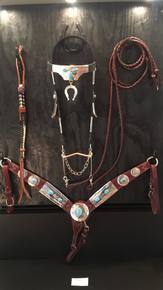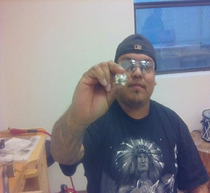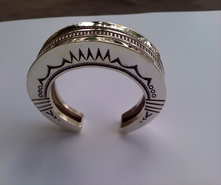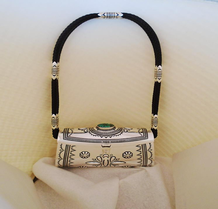Johnnie Bia, Jr. Diné College Psychology BA Intern, Office of Miss Navajo Nation
As I look into the Diné holistic components of Navajo silversmithing, I reached out to Master Silversmith, Leonard Gene and Emerging Silversmith, Waycee Harvey for some guidance. Leonard is Tó'aheedli'inii, born for Bit’ahnii, his maternal grandfathers are Ashii'hi, and his paternal grandfathers are Hashk'a'a i Hadzohí. He is originally from Rock Point, AZ. Waycee is Tachinii, born for Kinyaa'áanii, his maternal grandfathers are Todichinii, and paternal grandfathers are Tlaashchii. He is originally from Many Farms, AZ. He is apart of the 2017-2018 NCAP cohort and learning silversmithing from Don Denetdeal and Wilson Aronilth, Jr. I also took advantage of revisiting previous blogs written by former NCAPers, Delia Wauneka and Carlon Ami, to understand how the process of silversmithing makes us holistically unique.
frame, scribe, saw blades, files, acetylene tank, pliers, and creativity. This was the shopping list that was given to Waycee when he first started learning how to silversmith. From that basic tool kit, a silversmith can build up their supplies depending on the specialization they select (or I could also say the specialization that selects them). Specializations can include everything from stamping, overlay, in-lay, lapidary work, sand casting, tufa casting, and so forth.
feeling to the silversmith too - particularly when you finish a project to your liking. Delia also explored this elation in her blog "Wauneka's Meldown." On a NCAP trip to Meltdown Studios, Delia challenged herself to learn different techniques like chemical and electric etching. She also desperately wanted to learn how to make her own beads. It was somewhat of an emotional roller coaster: "I watched as Lauren did her demonstration, yet I struggled with this project and I decided to put it aside. Later on the day, I confronted my own self-doubts and challenged myself to finish one bead. You know what… I did it! I am so proud that now I can say, 'I made my own bead'". Delia explained that her self doubts were over come by her persistence. This is what Leonard must have meant when he reminded me that when you complete a project, it uplifts your spirit and makes you respect yourself for what you have done.
toughness you have to have. Carlon also wrote of this toughness in his blog "Just Take It Apart and Put It Back Together": "Don't let convention limit you. If you can reasonably imagine it, you might be able to build it. If it doesn't work out, you can always melt it down later for casting material." At the end of the process, there is a sense of satisfaction for completing the puzzle and having your ideas all come together. But the mental challenges don't stop there. When your done buffing and publishing, Leonard explained, there is a motivation released that inspires you to make improvements on the next project.
gives you another level of respect about what our culture means. With this understanding, you can have prayers done every now and then to help your work along and to keep you strong so you can continue your work with positive motivations. You can also sing songs while you’re working. It helps to stay connected with our traditional culture and values. After speaking with Leonard and Waycee, reconnecting with Carlon and Delia's blogs, and sitting in on some of the NCAP silversmithing classes, I can begin to understand how silver work helps an individual’s holistic well-being. There are physical demands when working with silver, sacred stones and minerals but you get energy, stamina, and motivation from them as well. Silversmithing is an emotional journey, bringing joy to you and others when your work is completed, even amidst the self-doubt and frustration during the process. This cultural art helps your mind to focus on the positive, which in turn, helps maintain creativity within your work. Ultimately, silversmithing as a Diné individual evokes a spiritual feeling through the stories and history of how Navajo people have always had silver and the sacred stones. Silversmithing has many benefits for a person who wants to learn. It will give you as much as you want to give to it.
And with that said...
1 Comment
James Hartman
3/9/2020 04:49:28 am
Do you know anything about the artist Gibson Gene?
Reply
Leave a Reply. |
Categories
All
Archives
October 2021
|
SocialsALL PHOTOS IMAGES ARE COPYRIGHT PROTECTED. PHOTO IMAGES USE IS SUBJECT TO PERMISSION BY THE NAVAJO CULTURAL ARTS PROGRAM. NO FORM OF REPRODUCTION IS PERMITTED WITHOUT WRITTEN PERMISSION FROM THE NAVAJO CULTURAL ARTS PROGRAM. |
Featured Pages |





